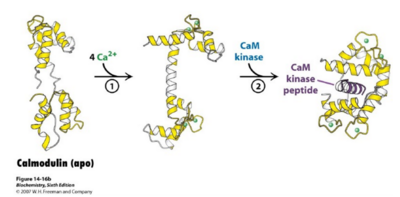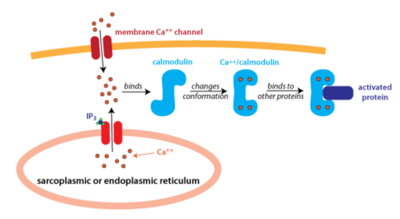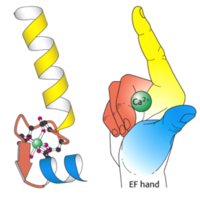Sandbox 4465
From Proteopedia
(Difference between revisions)
| Line 22: | Line 22: | ||
== Function == | == Function == | ||
| - | Each end of the <scene name='71/716518/Globulardomain/1'>globular domains</scene> of CaM binds to two Calcium ions, which allows CaM to bind to a total of four Calcium ions. The conformational changes which CaM undergoes allow it to be able to bind more specifically (Figure 1). Calmodulin elicits a pathway signal transduction by activating protein kinases which can then go on to phosphorylate other proteins, or other proteins can directly bind to Calmodulin<ref>doi: 10.1128/EC.01.1.119-125.2002</ref>. This would require that the other proteins have a specific binding motif or substrate binding mechanism for Calmodulin (Figure 2). Because there are many different types of binding motifs used by other proteins to interact with Calmodulin, there are no conserved amino acid sequences for CaM binding. EF-hand motifs are a common type of calcium binding motif. | + | Each end of the <scene name='71/716518/Globulardomain/1'>globular domains</scene> of CaM binds to two Calcium ions, which allows CaM to bind to a total of four Calcium ions. The conformational changes which CaM undergoes allow it to be able to bind more specifically (Figure 1). Calmodulin elicits a pathway signal transduction by activating protein kinases which can then go on to phosphorylate other proteins, or other proteins can directly bind to Calmodulin<ref>doi: 10.1128/EC.01.1.119-125.2002</ref>. This would require that the other proteins have a specific binding motif or substrate binding mechanism for Calmodulin (Figure 2). Because there are many different types of binding motifs used by other proteins to interact with Calmodulin, there are no conserved amino acid sequences for CaM binding. EF-hand motifs are a common type of calcium binding motif. These motifs can be characterized as having a helix-loop-helix pattern with 12 sequence residues. Aspartic acid, asparagine, glutamate, and serine are common residues found in this motif. By forming a loop, the motif allows calcium to bind more efficiently and securely (Figure 3). Once inside the binding site, calcium can then induce a conformational change.<ref>Lewit-Bentley, A., & Rèty S. (2000). EF-hand calcium-binding proteins. The Journal of current opinion in |
structural biology, 10(6), 637-643.doi:10.1016/S0959-440X(00)00142-1</ref>. | structural biology, 10(6), 637-643.doi:10.1016/S0959-440X(00)00142-1</ref>. | ||
Current revision
Calmodulin
| |||||||||||
Bibliography
- ↑ Eldik, L., & Watterson, D. (1998). Calmodulin and signal transduction
- ↑ Wolfe, D. M. D. M. (2006). Channeling studies in yeast: Yeast as a model for channelopathies?
- ↑

- ↑ MacNeil S., Dawson RA., Crocker G., Barton CH., Hanford L., McGurk MR., and Munro DS., (1988). Extracellular calmodulin and its association with epidermal growth factor in normal human body fluids.
- ↑ Berridge MJ, Lipp P, Bootman MD. The versatility and universality of calcium signalling. Nat Rev Mol Cell Biol. 2000 Oct;1(1):11-21. PMID:11413485 doi:http://dx.doi.org/10.1038/35036035
- ↑ "Cellular Communication: Introduction."Web. <http://courses.washington.edu/conj/bess/communication-overview/reg-overview.html>.
- ↑ Huang X, Liu Y, Wang R, Zhong X, Liu Y, Koop A, Chen SR, Wagenknecht T, Liu Z. Two potential calmodulin-binding sequences in the ryanodine receptor contribute to a mobile, intra-subunit calmodulin-binding domain. J Cell Sci. 2013 Oct 1;126(Pt 19):4527-35. doi: 10.1242/jcs.133454. Epub 2013 Jul, 18. PMID:23868982 doi:http://dx.doi.org/10.1242/jcs.133454
- ↑ Wriggers W, Mehler E, Pitici F, Weinstein H, Schulten K. Structure and dynamics of calmodulin in solution. Biophys J. 1998 Apr;74(4):1622-39. doi: 10.1016/S0006-3495(98)77876-2. PMID:9545028 doi:http://dx.doi.org/10.1016/S0006-3495(98)77876-2
- ↑ Lai M, Brun D, Edelstein SJ, Le Novere N. Modulation of calmodulin lobes by different targets: an allosteric model with hemiconcerted conformational transitions. PLoS Comput Biol. 2015 Jan 22;11(1):e1004063. doi: 10.1371/journal.pcbi.1004063. , eCollection 2015 Jan. PMID:25611683 doi:http://dx.doi.org/10.1371/journal.pcbi.1004063
- ↑ Chan KF, Chen WH. High performance capillary electrophoresis of calmodulin. Electrophoresis. 1990 Jan;11(1):15-8. PMID:2108018 doi:http://dx.doi.org/10.1002/elps.1150110104
- ↑ Bagchi IC, Huang QH, Means AR. Identification of amino acids essential for calmodulin binding and activation of smooth muscle myosin light chain kinase. J Biol Chem. 1992 Feb 15;267(5):3024-9. PMID:1737757
- ↑ http://www.ncbi.nlm.nih.gov/books/NBK98188/figure/grisar.f2/
- ↑ Joseph JD, Means AR. Calcium binding is required for calmodulin function in Aspergillus nidulans. Eukaryot Cell. 2002 Feb;1(1):119-25. doi: 10.1128/ec.01.1.119-125.2002. PMID:12455978 doi:http://dx.doi.org/10.1128/ec.01.1.119-125.2002
- ↑ Lewit-Bentley, A., & Rèty S. (2000). EF-hand calcium-binding proteins. The Journal of current opinion in structural biology, 10(6), 637-643.doi:10.1016/S0959-440X(00)00142-1
- ↑ Racioppi L, Noeldner PK, Lin F, Arvai S, Means AR. Calcium/calmodulin-dependent protein kinase kinase 2 regulates macrophage-mediated inflammatory responses. J Biol Chem. 2012 Mar 30;287(14):11579-91. doi: 10.1074/jbc.M111.336032. Epub, 2012 Feb 14. PMID:22334678 doi:http://dx.doi.org/10.1074/jbc.M111.336032
- ↑ Ui-Tei, K., Nagano, M., Sato, S., & Miyata, Y. (2000). Calmodulin-dependent and -independent apoptosis in cell of a drosophila neuronal cell line



